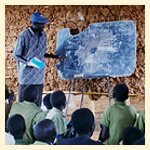* Note: Some of these reference resources were accessed for the preliminary literature review in 2010.
Some links may no longer be active.
Alberta Education (2007). English as a Second Language: Guide to Implementation K-9.
Bow Valley College: ESL Literacy Network. Essentials for LIFE. http://www.esl-literacy.com/essentials-life
British Columbia Ministry of Education (2009). Students from Refugee Backgrounds: a Guide for Teachers and Schools. https://www2.gov.bc.ca/assets/gov/education/administration/kindergarten-to-grade-12/diverse-student-needs/students-from-refugee-backgrounds-guide.pdf
Canada Citizenship and Immigration. Refugees. Retrieved April 4, 2011 from http://www.cic.gc.ca/english/refugees/index.asp
Churchill, S & Kaprielian-Churchill, I (1994). The Pulse of the World, Refugees in our Schools. Toronto: OISE Press.
Fantino. A & Colak, A. (2001). Refugee Children in Canada: Searching for Identity. Child Welfare LXXX, (5) 587-596.
Lee, E. (1988). Cultural Factors in working with Southeast Asian refugee adolescents. Journal of Adolescence, 2, 176-179.
MacKay, T. & Travares, T. (2005). Building Hope: Appropriate Programming for Adolescent and Young Adult Newcomers of War-affected Backgrounds and Manitoba Schools: A Preliminary report for Consultation and Discussion (2005). Manitoba Education, Citizenship and Youth.
Queen’s Printer for Ontario (2008). Supporting English Language Learners with Limited Prior Schooling: A Practical Guide for Ontario Educators, Grades 3 – 12. Retrieved from http://www.edu.gov.on.ca/eng/document/manyroots/ELL_LPS.pdf
Refugee Education Partnership Project (2007). The Education Needs of Young Refugees in Victoria. Retrieved from https://www.cmy.net.au/publications/education-needs-young-refugees-victoria
Sutherland, E. (2008). Refugee Children and Families: A Model for Successful Integration. Calgary, AB: Edna Sutherland and Associates.
United Nations High Commissioner for Refugees. UNHCR Global Appeal.



